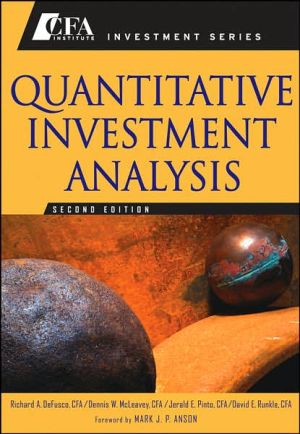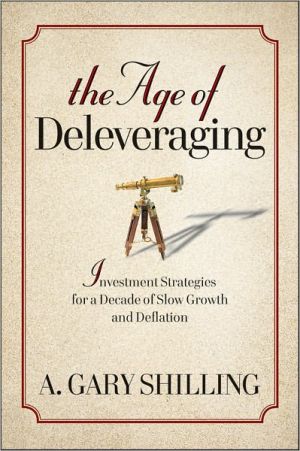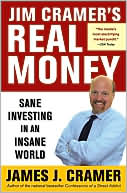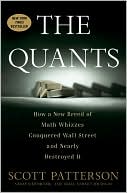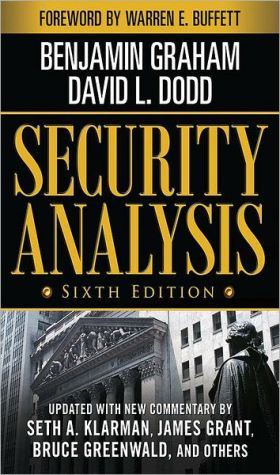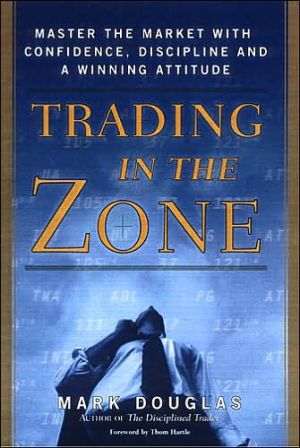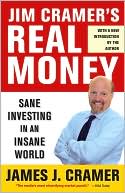Quantitative Investment Analysis
Praise for Quantitative Investment Analysis, Second Edition\ "Quantitative Investment Analysis is an essential book for any serious investor in today's financial markets. Cogently written, the authors cover a robust array of quantitative methods in a straightforward and digestible style. This book should be on everyone's short list of necessary reading and reference."\ —Gary P. Brinson, CFA, President, GP Brinson Investments\ "This second Edition of Quantitative Investment Analysis provides a...
Search in google:
As part of the CFA Institute Investment Series, the Second Edition of Quantitative Investment Analysis has been designed for a wide range of individuals, from graduate-level students focused on finance to practicing investment professionals. This globally relevant guide will help you understand quantitative methods and apply them to today's investment process.In this latest edition, the distinguished team of Richard DeFusco, Dennis McLeavey, Jerald Pinto, and David Runkle update information associated with this discipline; improve the presentation and coverage of several major areas, including regression, time series, and multifactor models; and introduce an even greater variety of investment-oriented examples—which reflect the changes currently taking place in the investment community. Throughout the text, special attention is paid to ensuring the even treatment of subject matter, consistency of mathematical notation, and continuity of topic coverage that is so critical to the learning process.Valuable for self-study and general reference, this book provides clear, example-driven coverage of a wide range of quantitative methods. Topics discussed include:The time value of moneyDiscounted cash flow applicationsCommon probability distributionsSampling and estimationHypothesis testingCorrelation and regressionMultiple regression and issues in regression analysisTime-series analysisPortfolio conceptsAnd to further enhance your understanding of the tools and techniques presented here, don't forget to pick up the Quantitative Investment Analysis Workbook, Second Edition—an essential guide containing learning outcomes and summary overview sections along with challenging problems and solutions.With each author bringing his own unique experiences and perspectives to the table, the Second Edition of Quantitative Investment Analysis distills the knowledge, skills, and abilities you need to succeed in today's fast-paced financial environment. Filled with in-depth insights and practical advice, Quantitative Investment Analysis, Second Edition offers a comprehensive treatment of quantitative methods that combines best practices with solid theory.
http://catalogimages.wiley.com/images/db/pdf/9780470052204.excerpt.pdf
Foreword xiiiAcknowledgments xviiIntroduction xixThe Time Value of Money 1Introduction 1Interest Rates: Interpretation 1The Future Value of a Single Cash Flow 3The Frequency of Compounding 8Continuous Compounding 10Stated and Effective Rates 12The Future Value of a Series of Cash Flows 13Equal Cash Flows-Ordinary Annuity 13Unequal Cash Flows 15The Present Value of a Single Cash Flow 15Finding the Present Value of a Single Cash Flow 15The Frequency of Compounding 17The Present Value of a Series of Cash Flows 19The Present Value of a Series of Equal Cash Flows 19The Present Value of an Infinite Series of Equal Cash Flows-Perpetuity 23Present Values Indexed at Times Other Than t = 0 24The Present Value of a Series of Unequal Cash Flows 26Solving for Rates, Number of Periods, or Size of Annuity Payments 27Solving for Interest Rates and Growth Rates 27Solving for the Number of Periods 30Solving for the Size ofAnnuity Payments 30Review of Present and Future Value Equivalence 35The Cash Flow Additivity Principle 36Discounted Cash Flow Applications 39Introduction 39Net Present Value and Internal Rate of Return 39Net Present Value and the Net Present Value Rule 40The Internal Rate of Return and the Internal Rate of Return Rule 42Problems with the IRR Rule 45Portfolio Return Measurement 47Money-Weighted Rate of Return 47Time-Weighted Rate of Return 49Money Market Yields 54Statistical Concepts and Market Returns 61Introduction 61Some Fundamental Concepts 61The Nature of Statistics 62Populations and Samples 62Measurement Scales 63Summarizing Data Using Frequency Distributions 65The Graphic Presentation of Data 72The Histogram 73The Frequency Polygon and the Cumulative Frequency Distribution 74Measures of Central Tendency 76The Arithmetic Mean 77The Median 81The Mode 84Other Concepts of Mean 85Other Measures of Location: Quantiles 94Quartiles, Quintiles, Deciles, and Percentiles 94Quantiles in Investment Practice 98Measures of Dispersion 100The Range 100The Mean Absolute Deviation 101Population Variance and Population Standard Deviation 103Sample Variance and Sample Standard Deviation 106Semivariance, Semideviation, and Related Concepts 110Chebyshev's Inequality 111Coefficient of Variation 113The Sharpe Ratio 115Symmetry and Skewness in Return Distributions 118Kurtosis in Return Distributions 123Using Geometric and Arithmetic Means 127Probability Concepts 129Introduction 129Probability, Expected Value, and Variance 129Portfolio Expected Return and Variance of Return 152Topics in Probability 161Bayes' Formula 161Principles of Counting 166Common Probability Distributions 171Introduction 171Discrete Random Variables 171The Discrete Uniform Distribution 173The Binomial Distribution 175Continuous Random Variables 185Continuous Uniform Distribution 186The Normal Distribution 189Applications of the Normal Distribution 197The Lognormal Distribution 200Monte Carlo Simulation 206Sampling and Estimation 215Introduction 215Sampling 215Simple Random Sampling 216Stratified Random Sampling 217Time-Series and Cross-Sectional Data 219Distribution of the Sample Mean 221The Central Limit Theorem 222Point and Interval Estimates of the Population Mean 225Point Estimators 225Confidence Intervals for the Population Mean 227Selection of Sample Size 233More on Sampling 235Data-Mining Bias 236Sample Selection Bias 238Look-Ahead Bias 240Time-Period Bias 240Hypothesis Testing 243Introduction 243Hypothesis Testing 244Hypothesis Tests Concerning the Mean 253Tests Concerning a Single Mean 254Tests Concerning Differences between Means 261Tests Concerning Mean Differences 265Hypothesis Tests Concerning Variance 269Tests Concerning a Single Variance 269Tests Concerning the Equality (Inequality) of Two Variances 271Other Issues: Nonparametric Inference 275Tests Concerning Correlation: The Spearman Rank Correlation Coefficient 276Nonparametric Inference: Summary 279Correlation and Regression 281Introduction 281Correlation Analysis 281Scatter Plots 281Correlation Analysis 282Calculating and Interpreting the Correlation Coefficient 283Limitations of Correlation Analysis 287Uses of Correlation Analysis 289Testing the Significance of the Correlation Coefficient 297Linear Regression 300Linear Regression with One Independent Variable 300Assumptions of the Linear Regression Model 303The Standard Error of Estimate 306The Coefficient of Determination 309Hypothesis Testing 310Analysis of Variance in a Regression with One Independent Variable 318Prediction Intervals 321Limitations of Regression Analysis 324Multiple Regression and Issues in Regression Analysis 325Introduction 325Multiple Linear Regression 325Assumptions of the Multiple Linear Regression Model 331Predicting the Dependent Variable in a Multiple Regression Model 336Testing Whether All Population Regression Coefficients Equal Zero 338Adjusted R[superscript 2] 340Using Dummy Variables in Regressions 341Violations of Regression Assumptions 345Heteroskedasticity 345Serial Correlation 351Multicollinearity 356Heteroskedasticity, Serial Correlation, Multicollinearity: Summarizing the Issues 359Model Specification and Errors in Specification 359Principles of Model Specification 359Misspecified Functional Form 360Time-Series Misspecification (Independent Variables Correlated with Errors) 368Other Types of Time-Series Misspecification 372Models with Qualitative Dependent Variables 372Time-Series Analysis 375Introduction 375Challenges of Working with Time Series 375Trend Models 377Linear Trend Models 377Log-Linear Trend Models 380Trend Models and Testing for Correlated Errors 385Autoregressive (AR) Time-Series Models 386Covariance-Stationary Series 386Detecting Serially Correlated Errors in an Autoregressive Model 387Mean Reversion 391Multiperiod Forecasts and the Chain Rule of Forecasting 391Comparing Forecast Model Performance 394Instability of Regression Coefficients 397Random Walks and Unit Roots 399Random Walks 400The Unit Root Test of Nonstationarity 403Moving-Average Time-Series Models 407Smoothing Past Values with an n-Period Moving Average 407Moving-Average Time-Series Models for Forecasting 409Seasonality in Time-Series Models 412Autoregressive Moving-Average Models 416Autoregressive Conditional Heteroskedasticity Models 417Regressions with More than One Time Series 420Other Issues in Time Series 424Suggested Steps in Time-Series Forecasting 425Portfolio Concepts 429Introduction 429Mean-Variance Analysis 429The Minimum-Variance Frontier and Related Concepts 430Extension to the Three-Asset Case 439Determining the Minimum-Variance Frontier for Many Assets 442Diversification and Portfolio Size 445Portfolio Choice with a Risk-Free Asset 449The Capital Asset Pricing Model 458Mean-Variance Portfolio Choice Rules: An Introduction 460Practical Issues in Mean-Variance Analysis 464Estimating Inputs for Mean-Variance Optimization 464Instability in the Minimum-Variance Frontier 470Multifactor Models 473Factors and Types of Multifactor Models 474The Structure of Macroeconomic Factor Models 475Arbitrage Pricing Theory and the Factor Model 478The Structure of Fundamental Factor Models 484Multifactor Models in Current Practice 485Applications 493Concluding Remarks 509Appendices 511References 521Glossary 527About the CFA Program 541About the Authors 543Index 545
